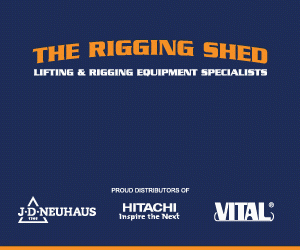)
My Kind of People
I have a lot of conversations with fellow business owners and managers here in Sydney and wider Australia. It’s fascinating to compare notes with peers who are experiencing the same challenges and notable that similar issues impact us all. Near the top of the list, especially for those of us plying our trade in a niche sector, like lifting, is recruitment, which can become something of a quagmire if it isn’t navigated correctly.
As I’ve written before, a business is nothing and nowhere without its people; we’re honest enough to acknowledge that at my company. So we have had to become adept at finding, retaining, motivating, and training staff. Circumstances dictate that we have to be as efficient in those departments as we are at working with lifting and rigging gear. And I know other business leaders feel the same; we’re all industry professionals first, but investors in people a close second.
It’s opportune, therefore, to talk about the challenges we’ve experienced that might serve as lessons for others. First, it’s important to accept realities. The Australian population is ridiculously small compared to its landmass, coupled with which if a business is not based in close proximity to any of the country’s major equipment manufacturers, access to training can be scarce. It’s also true that there is a shortage of people with relevant skills and many from the younger generation gravitate towards the technological rather than industrial or engineering space.
A golden rule that has served us well is to show a bias towards attitude over qualifications. That doesn’t mean we send someone equipped only with enthusiasm and passion into a situation where they don’t also have the skills, but the person with the more impressive resume might turn out to be the worst candidate for a particular job or company. It’s true that attitude, work ethic, drive and loyalty – fundamental assets for anyone who reports for duty at many companies – are the hardest to find.
Youth versus experience
In a sector, like ours, that demands competency, these realities can create a conundrum. Now we’re 21 years old as a business, we have a great team of people in place, but would we be better advised to only recruit young, relatively untrained people and mould them into the shape of the company, or adopt a more zenith level recruitment strategy where we attract seasoned professionals. The answer is probably both, but then how many of each? And which is more important? We ask ourselves these questions a lot.
There are positives and negatives to observe. A more experienced person will likely bring knowledge and contacts, but they would have been mentored and nurtured by another business. Someone of a particular seniority may also harbour ideals from a previous era and be somewhat neophobic. Further, they might bring one or two bad habits that have been allowed to fester in the employment of another. More investment in terms of time, management, and training will be required with a younger, less experienced individual, but they won’t have any baggage or preconceived ideas. It’s important to continually weigh up the options.
If the right person, of whatever age and ability, becomes available, I’d encourage any business to make their move, regardless of immediate openings. A business should be dynamic enough to find space for the right person. I’ve never subscribed to the argument: ‘If only we had a vacancy for…to fill. What an asset to the company they could’ve been.’ Get them on board. All that said, more commonly, a traditional recruitment campaign is required, tailored to the nature of a new opening or vacated position. There are five methods we’ve used in the past, all to varying levels of success. I’ve picked a pro and con for each to help you consider the options:
- Recruitment agencies
Pro: They take away a lot of the burden in contacting candidates.
Con: They can cast too big a net and put average candidates forward for jobs.
- Direct contact
Pro: Leveraging relationships is highly efficient; it’s a great way to advance recruitment with a specific individual quickly.
Con: It’s time consuming and reduces the size of the pond one can fish in.
- Referrals
Pro: It gives assurances that someone has performed sufficiently enough to earn an endorsement.
Con: People might be looking out for an old friend rather than referring based on the job in hand.
- Paid for advertisements
Pro: Another efficient way of reaching a large audience, quickly.
Con: We’ve found that the quality of candidates is generally poor, however.
- Advertisements through the company (website, etc.)
Pro: It’s free promotion and ensures a message reaches those already interested in the business or brand. We’ve found some good people this way.
Con: There’s an inherent limitation to the outreach.
Q&A
I get asked a lot about interviewing technique. I’m a believer in putting a variety of questions to candidates to get a better feel for the person rather than the façade they’ve put on to impress the panel. Posing questions that have nothing to do with work is an effective technique but I’d urge interviewers to tread this path with caution. A balance has to be struck between assessing a person’s likely compatibility with company culture and being too personal. Nobody will appreciate being asked too many questions about their interests, family, and values. It could appear over familiar and might put off a good candidate.
Once people are in the door, keeping the good ones is just as important as finding them in the first place. We have a saying here at Ranger, “You either last six months or 10 years.” There doesn’t seem to be an in-between, and from what my peers at other businesses say, that’s often the case at growing, dynamic companies. We’re always transparent about that during recruitment; we’re a fast-paced operation and we expect a lot from staff. At times, it’s a stressful environment and that’s not for everyone. It’s not about the survival of the fittest, but it’s no place for clock-watchers. The return however is that most businesses in a phase of growth often support expansion with great company culture.
A cornerstone of firms that retain their staff is a commitment to nurturing talent and helping people grow in line with their skillsets. Good companies tend not to micromanage their talent; they let staff take ownership of their positions and, instead of being overbearing, they simply provide the learning, support, and tools to allow them to be successful. Of course, it’s important to set parameters but they shouldn’t be too restrictive. I’ve met – and employed – a lot of great people who were suffocated in previous roles.
A common shortcoming of certain companies is a blinkered approach to personal development and staff training. It’s a flaw often related to managers’ or owners’ fears that they’ll invest time and money in enhancing a person’s skillset only for them to leave and give another company the benefit of that experience. It’s a naive way of looking at it because good people don’t leave good businesses or want to walk away from good managers. And there’s a bigger picture to observe too. The more companies that invest in training, the better best practices will become, and the safer every job site will be. We should all see ourselves as stakeholders in that endeavour.
It takes a steady hand to monitor and manage a company’s training programme, with every member of staff at different stages of learning and renewals coming round quickly as time speeds by, as it tends to do. That’s where the value of a top-notch quality assurance (QA) team presents itself, which is another department too often overlooked by some firms. We made this an area of focus around the time we were rebranding and completely rewrote our policies, procedures, manuals and everything else that we relied upon during tenders or bids for large contracts. Alongside recruitment, it’s another area I’d encourage all readers to look at closer as the second half of the year gathers pace.
Good luck with your upcoming recruitment campaigns.









